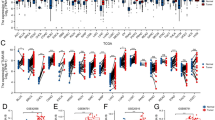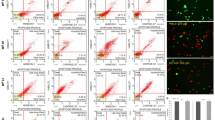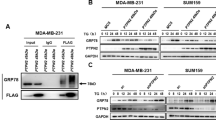Abstract
Aim:
Tubeimoside-1 (TBMS1), a triterpenoid saponin extracted from the Chinese herbal medicine Bolbostemma paniculatum (Maxim) Franquet (Cucurbitaceae), has shown anticancer activities in various cancer cell lines. The aim of this study was to investigate the anticancer activity and molecular targets of TBMS1 in human prostate cancer cells in vitro.
Methods:
DU145 and P3 human prostate cancer cells were treated with TBMS1. Cell viability and apoptosis were detected. ROS generation, mitochondrial membrane potential and cell cycle profile were examined. Western blotting was used to measure the expression of relevant proteins in the cells.
Results:
TBMS1 (5–100 μmol/L) significantly suppressed the viability of DU145 and P3 cells with IC50 values of approximately 10 and 20 μmol/L, respectively. Furthermore, TBMS1 dose-dependently induced apoptosis and cell cycle arrest at G0/G1 phase in DU145 and P3 cells. In DU145 cells, TBMS1 induced mitochondrial apoptosis, evidenced by ROS generation, mitochondrial dysfunction, endoplasmic reticulum stress, modulated Bcl-2 family protein and cleaved caspase-3, and activated ASK-1 and its downstream targets p38 and JNK. The G0/G1 phase arrest was linked to increased expression of p53 and p21 and decreased expression of cyclin E and cdk2. Co-treatment with Z-VAD-FMK (pan-caspase inhibitor) could attenuate TBMS1-induced apoptosis but did not prevent G0/G1 arrest. Moreover, co-treatment with NAC (ROS scavenger), SB203580 (p38 inhibitor), SP600125 (JNK inhibitor) or salubrinal (ER stress inhibitor) significantly attenuated TBMS1-induced apoptosis.
Conclusion:
TBMS1 induces oxidative stress-mediated apoptosis in DU145 human prostate cancer cells in vitro via the mitochondrial pathway.
Similar content being viewed by others
Log in or create a free account to read this content
Gain free access to this article, as well as selected content from this journal and more on nature.com
or
References
Zhang X, Chen M, Zou P, Kanchana K, Weng Q, Chen W, et al. Curcumin analog WZ35 induced cell death via ROS-dependent ER stress and G2/M cell cycle arrest in human prostate cancer cells. BMC Cancer 2015 Nov 6; 15: 866. doi: 10.1186/s12885-015-1851-3.
Bayne CE, Williams SB, Cooperberg MR, Gleave Me, Graefen M, Montorsi F, et al. Treatment of the primary tumor in metastatic prostate cancer: current concepts and future perspectives. Eur Urol 2015; pii: S0302-2838(15)00378-4.
Kim HJ, Phak JH, Kim WC . Prostate-specific antigen kinetics following hypofractionated stereotactic body radiotherapy boost and whole pelvic radiotherapy for intermediate- and high-risk prostate cancer. Asia Pac J Clin Oncol 2016. doi: 10.1111/ajco.12472.
Tsao CK, Cutting E, Martin J, Oh WK . The role of cabazitaxel in the treatment of metastatic castration-resistant prostate cancer. Ther Adv Urol 2014; 6: 97–104.
Schutz FA, Buzaid AC, Sartor O . Taxanes in the management of metastatic castration-resistant prostate cancer: efficacy and management of toxicity. Crit Rev Oncol Hematol 2014; 91: 248–56.
Khan M, Maryam A, Zhang H, Mehmood T, Ma T . Killing cancer with platycodin D through multiple mechanisms. J Cell Mol Med 2016; 20: 389–402.
Zong WX, Rabinowitz JD, White E . Mitochondria and cancer. Mol Cell 2016; 61: 667–76
Juan ME, Wenzel U, Daniel H, Planas JM . Resveratrol induces apoptosis through ROS-dependent mitochondria pathway in HT-29 human colorectal carcinoma cells. J Agric Food Chem 2008; 56: 4813–8.
Trachootham D, Alexandre J, Huang P . Targeting cancer cells by ROS-mediated mechanisms: a radical therapeutic approach? Nat Rev Drug Discov 2009; 8: 579–91.
Alberti C . Taxane- and epothilone-based chemotherapy: from molecule cargo cytoskeletal logistics to management of castration-resistant prostate carcinoma. Eur Rev Med Pharmacol Sci 2013; 17: 1658–64.
Wang CY, Bai XY, Wang CH . Traditional Chinese medicine: a treasured natural resource of anticancer drug research and development. Am J Chin Med 2014; 42: 543–59.
Li X, Yang G, Li X, Zhang Y, Yang J, Chang J, et al. Traditional Chinese medicine in cancer care: a review of controlled clinical studies published in Chinese. PLoS One 2013; 8: e 60338.
Ling CQ, Yue XQ, Ling C . Three advantages of using traditional Chinese medicine to prevent and treat tumor. J Integr Med 2014; 12: 331–5.
Jia G, Wang Q, Wang R, Deng D, Xue L, Shao N, et al. Tubeimoside-1 induces glioma apoptosis through regulation of Bax/Bcl-2 and the ROS/cytochrome c/caspase-3 pathway. Onco Targets Ther 2015; 30: 303–11.
Xu Y, Wang G, Chen Q, Lin T, Zeng Z, Luo Q, et al. Intrinsic apoptotic pathway and G2/M cell cycle arrest involved in tubeimoside I-induced EC109 cell death. Chin J Cancer Res 2013; 25: 312–21.
Chen WJ, Yu C, Yang Z, He JL, Yin J, Liu HZ, et al. Tubeimoside-1 induces G2/M phase arrest and apoptosis in SKOV-3 cells through increase of intracellular Ca2+ and caspase-dependent signaling pathways. Int J Oncol 2012; 40: 535–43.
Liu HZ, Yu C, Yang Z, He JL, Chen WJ, Yin J, et al. Tubeimoside I sensitizes cisplatin in cisplatin-resistant human ovarian cancer cells (A2780/DDP) through down-regulation of ERK and up-regulation of p38 signaling pathways. Mol Med Rep 2011; 4: 985–92.
Huang P, Yu C, Liu XQ, Ding YB, Wang YX, He JL . Cytotoxicity of tubeimoside I in human choriocarcinoma JEG-3 cells by induction of cytochrome c release and apoptosis via the mitochondrial-related signaling pathway. Int J Mol Med 2011; 28: 579–87.
Zhang Y, Xu X, He P . Tubeimoside-1 inhibits proliferation and induces apoptosis by increasing the Bax to Bcl-2 ratio and decreasing COX-2 expression in lung cancer A549 cells. Mol Med Rep 2011; 4: 25–9.
Xu Y, Ching YP, Zhou Y, Chiu JF, Chen F, He QY . Multiple pathways were involved in tubeimoside-1-induced cytotoxicity of HeLa cells. J Proteomics 2011; 75: 491–501.
Khan M, Ding C, Rasul A, Yi F, Li T, Gao H, et al. Isoalantolactone induces reactive oxygen species mediated apoptosis in pancreatic carcinoma PANC-1 cells. Int J Biol Sci 2012; 8: 533–47.
Khan M, Zheng B, Yi F, Rasul A, Gu Z, Li T, et al. Pseudolaric acid B induces caspase-dependent and caspase-independent apoptosis in u87 glioblastoma cells. Evid Based Complement Alternat Med 2012: 957568.
Khan M, Yi F, Rasul A, Li T, Wang N, Gao H, et al. Alantolactone induces apoptosis in glioblastoma cells via GSH depletion, ROS generation, and mitochondrial dysfunction. IUBMB Life 2012; 64: 783–94.
Abbas T, Dutta A . p21 in cancer: intricate networks and multiple activities. Nat Rev Cancer 2009; 9: 400–14.
Yu JS, Kim AK . Platycodin D induces reactive oxygen species-mediated apoptosis signal-regulating kinase 1 activation and endoplasmic reticulum stress response in human breast cancer cells. J Med Food 2012; 15: 691–9.
Khan M, Maryam A, Qazi JI, Ma T . Targeting apoptosis and multiple signaling pathways with Icariside II in cancer cells. Int J Biol Sci 2015; 11: 1100–12.
Hengartner MO . The biochemistry of apoptosis. Nature 2000; 407: 770–6.
Ferreira CG, Epping M, Kruyt FA, Giaccone G . Apoptosis: target of cancer therapy. Clin Cancer Res 2002; 8: 2024–34.
Trachootham D, Alexandre J, Huang P . Targeting cancer cells by ROS-mediated mechanisms: a radical therapeutic approach? Nat Rev Drug Discov 2009; 8: 579–91.
Zhu L, Ren L, Chen Y, Fang J, Ge Z, Li X . Redox status of high-mobility group box 1 performs a dual role in angiogenesis of colorectal carcinoma. J Cell Mol Med 2015; 19: 2128–35.
Hong YH, Uddin MH, Jo U, Kim B, Song J, Suh DH, et al. ROS accumulation by PEITC selectively kills ovarian cancer cells via UPR-mediated apoptosis. Front Oncol 2015; 5: 167.
Wei C, Xiao Q, Kuang X, Zhang T, Yang Z, Wang L . Fucoidan inhibits proliferation of the SKM-1 acute myeloid leukaemia cell line via the activation of apoptotic pathways and production of reactive oxygen species. Mol Med Rep 2015; 12: 6649–55.
Seo KH, Ryu HW, Park MJ, Park KH, Kim JH, Lee MJ, et al. Mangosenone F, a furanoxanthone from Garciana mangostana, induces reactive oxygen species-mediated apoptosis in lung cancer cells and decreases Xenograft tumor growth. Phytother Res 2015; 29: 1753–60.
Saitoh M, Nishitoh H, Fujii M, Takeda K, Tobiume K, Sawada Y, et al. Mammalian thioredoxin is a direct inhibitor of apoptosis signal-regulating kinase (ASK) 1. EMBO J 1998; 17: 2596–606.
Oyadomari S, Mori M . Roles of CHOP/GADD153 in endoplasmic reticulum stress. Cell Death Differ 2004; 11: 381–9.
Yu JS, Kim AK . Platycodin D induces apoptosis in MCF-7 human breast cancer cells. J Med Food 2010; 13: 298–305.
Khan M, Yu B, Rasul A, Al Shawi A, Yi F, Yang H, et al. Jaceosidin induces apoptosis in U87 glioblastoma cells through G2/M phase arrest. Evid Based Complement Alternat Med 2012: 703034.
Khan M, Rasul A, Yi F, Zhong L, Ma T . Jaceosidin induces p53-dependent G2/M phase arrest in U87 glioblastoma cells. Asian Pac J Cancer Prev 2011; 12: 3235–8.
Lunn CL, Chrivia JC, Baldassare JJ . Activation of Cdk2/cyclin E complexes is dependent on the origin of replication licensing factor Cdc6 in mammalian cells. Cell Cycle 2010; 9: 4533–41.
Yin Y, Chen W, Tang C, Ding H, Jang J, Weng M, et al. NF-kappaB, JNK and p53 pathways are involved in tubeimoside-1-induced apoptosis in HepG2 cells with oxidative stress and G(2)/M cell cycle arrest. Food Chem Toxicol 2011; 49: 3046–54.
Acknowledgements
This work was supported by the Science and Technology Development Project of Jilin Province (No 3D515U393429), National Natural Science Fundation of China (No 81402330).
Author information
Authors and Affiliations
Corresponding author
Rights and permissions
About this article
Cite this article
Yang, Jb., Khan, M., He, Yy. et al. Tubeimoside-1 induces oxidative stress-mediated apoptosis and G0/G1 phase arrest in human prostate carcinoma cells in vitro. Acta Pharmacol Sin 37, 950–962 (2016). https://doi.org/10.1038/aps.2016.34
Received:
Accepted:
Published:
Issue date:
DOI: https://doi.org/10.1038/aps.2016.34
Keywords
This article is cited by
-
Saponins as cytotoxic agents: an update (2010–2021). Part II—Triterpene saponins
Phytochemistry Reviews (2023)
-
The endoplasmic reticulum stress response in prostate cancer
Nature Reviews Urology (2022)
-
Tubeimoside-I sensitizes colorectal cancer cells to chemotherapy by inducing ROS-mediated impaired autophagolysosomes accumulation
Journal of Experimental & Clinical Cancer Research (2019)
-
Tubeimoside-1, a triterpenoid saponin, induces cytoprotective autophagy in human breast cancer cells in vitro via Akt-mediated pathway
Acta Pharmacologica Sinica (2019)



